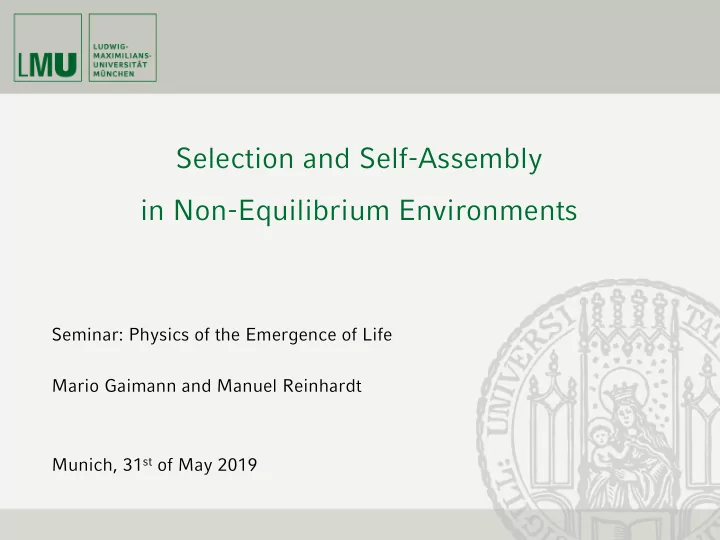

Selection and Self-Assembly in Non-Equilibrium Environments Seminar: Physics of the Emergence of Life Mario Gaimann and Manuel Reinhardt Munich, 31 st of May 2019
Motivation Chemical Selection as a Corner Stone of Life Select a wanted product in a large and complex reaction network Attractive mechanism for the formation of protocells out of prebiotic molecules For living systems, a selection mechanism has to work outside of equilibrium
Simplified Chemical Reaction Network
Chemical Reaction Network Components Product C n C n Precursor C n C 3 C 3 C 3 C 4 C 4 C 4 Nonsymmetric Products are also C 5 C 5 C 5 possible, e.g. C 4 C 5 or C 3 C 6. C 6 C 3 C 6 C 6 C 6 M. Tena-Solsona et al., Nat. Commun. 9, 2044 (2018)
Chemical Reaction Network Products are very Fuel unstable , decay quickly by hydrolysis. Precursor C n C n 2H + There are more chemical processes involved than Intermediate C n * depicted here (e.g. back H 2 O reactions). C n R= –C 2 H 5 –C 3 H 7 The experimental group –C 4 H 9 Waste developed a kinetic model –C 5 H 11 Product C n C n in Matlab where most processes are included. M. Tena-Solsona et al., Nat. Commun. 9, 2044 (2018)
Experimental Setup Experiment 1: Single Precursor • Mix 300 mM of one precursor and 10 mM of fuel (EDC) • Measure product (anhydride) Precursor C n Fuel concentration as a function of time Reasonable Expectations • All precursors are chemically very similar ⇒ should exhibit similar behavior • Anhydride concentration grows rapidly at first but also decays quickly M. Tena-Solsona et al., Nat. Commun. 9, 2044 (2018)
Experimental Results Observations Anhydride concentrations 5 • Longer anhydrides hydrolyze 60 min (decay) more slowly 4 Concentration (mM) • C 5 C 5 and C 6 C 6 concentrations 3 especially show a very C 3 C 3 pronounced long tail 2 C 4 C 4 • For C 5 C 5 and C 6 C 6 : Solution C 5 C 5 becomes turbid as soon as fuel is 1 C 6 C 6 added 0 40 80 120 Q: What could explain the special Time (min) behavior of C 5 C 5 and C 6 C 6 ? M. Tena-Solsona et al., Nat. Commun. 9, 2044 (2018)
<latexit sha1_base64="Bg1GdqtrhIg84B0Uj+tY6wV0f/U=">ABt3icbY7NSsNQEIUn9a/Gv6hLN8G6cGNJ6kJcCEVBFBQq2B8wJdzcTJpLk9yYe1MoMY/gA+hLuPA5XLpwo69iokXQelbfnDPDHCcOmJCG8aZUZmbn5heqi+rS8srqmra+0RE8TSi2KQ940nOIwIBF2JZMBtiLEyShE2DXGZ6UeXeEiWA8upbjGPshGUTMY5TIwrK185FthUT6wsv8sZvwYCyYyPUjfivb0kWotDFT0iMmYu5rZWM+rGl/RpMCdQa+483L83z2bK1ruZymIUaSBkSIG9OIZT8jiWQ0wFxVrVRgTOiQDBLI0a5i3vl21y1BMqSPB7J7JQlRL8sJv2CDXyZq0UT8+/faeg06uZ+vXFVDqGb1VhC7ZhF0w4gCacQvaQOEJXuEdPpRDxVY8xf9erSiTm034JeX2E+jefs0=</latexit> Phase Separation Phase separation Anhydride persistency factors No inhibition Inhibition 2 C 3 100 C 5 Persistency factor 4 C 5 C 5 C 3 C 3 2 10 Oil 4 droplet 2 Aqueous solution 1 C 3 C 3 C 4 C 4 C 5 C 5 C 6 C 6 Const. � ���������� � � ���������� � � ��������� Reaction Reaction Solubility rate constant M. Tena-Solsona et al., Nat. Commun. 9, 2044 (2018)
Competition Experiment: Setup M. Tena-Solsona et al., Nat. Commun. 9, 2044 (2018) 9
Competition Experiment: Setup M. Tena-Solsona et al., Nat. Commun. 9, 2044 (2018) 10
Competition Experiment: Setup M. Tena-Solsona et al., Nat. Commun. 9, 2044 (2018) 11
Competition Experiment: Expectations? Chemical Reaction Network: Higher abundance of C 3 C 5 ? Ø Two pathways for C 3 C 5 M. Tena-Solsona et al., Nat. Commun. 9, 2044 (2018) 12
Competition Experiment: Results M. Tena-Solsona et al., Nat. Commun. 9, 2044 (2018)
Competition Experiment: Results Low fuel concentration: v Higher abundance of C 3 C 5 v No phase separation M. Tena-Solsona et al., Nat. Commun. 9, 2044 (2018)
Competition Experiment: Results Low fuel concentration: v Higher abundance of C 3 C 5 v No phase separation M. Tena-Solsona et al., Nat. Commun. 9, 2044 (2018) 15
Competition Experiment: Results High fuel concentration: Low fuel concentration: v Higher abundance of C 3 C 5 v Higher abundance of C 5 C 5 v Phase separation slows decay of v No phase separation C 5 C 5 , cumulative advantage! M. Tena-Solsona et al., Nat. Commun. 9, 2044 (2018) 16
Competition Experiment: Discussion Persistence and growth of existing droplets over many cycles M. Tena-Solsona et al., Nat. Commun. 9, 2044 (2018) 17
Competition Experiment: Discussion The longer hydrophobic anhydride C 5 C 5 is self-selected in an non-equilibrium environment! Kinetic selection, not thermodynamic selection! Persistence and growth of existing droplets over many cycles M. Tena-Solsona et al., Nat. Commun. 9, 2044 (2018) 18
Towards the Origin of Life Extension of the model: Incorporate more precursors (C 3 , C 4 , C 5 , C 6 ) Ø Product with longest carbon chain C 6 C 6 is self-selected M. Tena-Solsona et al., Nat. Commun. 9, 2044 (2018) 19
Towards the Origin of Life Extension of the model: Incorporate more precursors (C 3 , C 4 , C 5 , C 6 ) Ø Product with longest carbon chain C 6 C 6 is self-selected Non-equilibrium self- selection as a general principle M. Tena-Solsona et al., Nat. Commun. 9, 2044 (2018) 20
Potential Applications Precursor v Self-erasing inks with tuneable lifetimes 1 cm Anhydride M. Tena-Solsona et al., Nat. Commun. 8, 15895 (2017) 21
Potential Applications Precursor v Self-erasing inks with tuneable lifetimes 1 cm Anhydride v Kinetic trapping of carboxylate precursors into fibres Anhydride gel with +100 mM fuel carboxylate fibres Precursor 10 µm after 10 min after 24 hr M. Tena-Solsona et al., Nat. Commun. 8, 15895 (2017) 22
Recap No inhibition Inhibition C 3 C 5 C 5 C 5 C 3 C 3 Oil droplet Aqueous solution A simple reaction network as a Phase separation inhibits decay of model of reality some Products Slow decay can be used as a selection mechanism. For this to work we need fuel and starvation cycles. M. Tena-Solsona et al., Nat. Commun. 9, 2044 (2018)
References References 1. M. Tena-Solsona et al., Nat. Commun. 8 , 15895 (2017) 2. M. Tena-Solsona et al., Nat. Commun. 9 , 2044 (2018) 3. "Carboxylic acid." Wikipedia, The Free Encyclopedia, 30 May 2019.
Recommend
More recommend